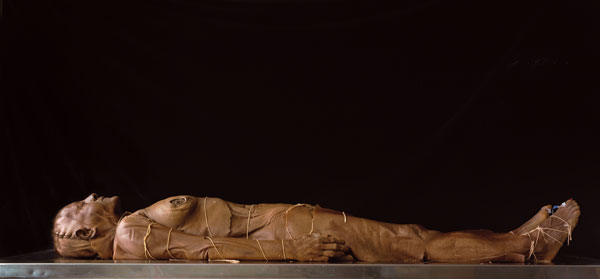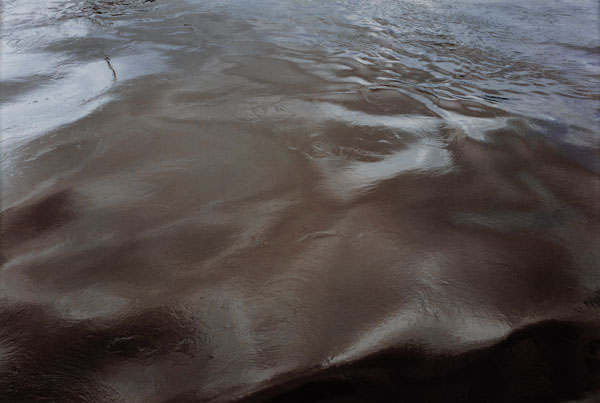[Spring/Summer 2011]
by Jacques Doyon
Jacques Doyon: I gather from your introduction of the theme for the next MPM that there is an initial polarization that defines the territory that you propose to investigate. What interests you primarily arises from an introspective dimension, based not so much on expression as on self-transformation. This inner lucidity seems to be, in a way, opposed to a more distanced, analytical view of the realities of the world and the social responsibilities of individuals and even nations. Yet, the line between objectivity and subjectivity is quite thin – the objectivity of photography has often been questioned – so how does this dimension of interiority figure into the works that you have selected, on either the level of issues raised or how they are treated, and how do you differentiate it from more distanced approaches?
Anne-Marie Ninacs: Your question requires me to take a step back and start by situating Lucidity: Inward Views in the perspective of my interests as a curator. My projects almost always concern questions essential to human life (such as, How do we use our time? How do we inhabit motion? What is identity? Is our reality made of illusions?), in which the subject plays a central role. The subjective experience of the world is territory to which I return again and again, the topography that I am interested in exploring. In this context, the selected artworks are much more than illustrations of a theme that I may have chosen; they offer real opportunities for meditation on the philosophical questions with which I am preoccupied. I see them for myself as “tools for living,” and it is in this sense that I want to present them to the public. I think that we can learn to live from artworks – certain ones, at any rate – and this single subject-object relationship complexifies the polarization that you mentioned. For a long time, I thought that everything is inextricably bound to subjectivity and that objectivity does not exist except as a reassuring fiction. Today, the “inward” in the event’s title serves to form an image and gives a quick indication of the territory that I am interested in exploring, but it should not be seen as a simplification. Rather, these days I observe the point to which “inward” and “outward” are communicating vessels: our relationship with the physical world, of which we are an integral part, is so intense that our psyches are furnished with objects and images that are constantly being reorganized and give rise, in turn, to new objects, images, and gestures that we create and add to the physical world. It is like breathing in and out, and it happens thousands of times a day.
It is precisely because I am interested in this connection between outward and inward that I am curating this edition of Mois de la Photo à Montréal. Our obsessive reflections about the state of the world and our responsibilities as citizens make us feel lucid. Within these reflections are conflicts, abuses of power, unattainable ideals, and pollutants that play out within our very bodies and minds and are responsible for our infinite unconscious reactions, yet remain utterly unexplored. Part of the solution to our global problems, however, is found in our capacity to recognize these micro-conflicts within us and eventually to solve them. Thus, it is not so much op- position to working with socio-political content that I am calling for, but a link to or extension of the questions that it raises. It is not enough, in my view, to be aware of and decry the problems that surround us; we must come to a realization of how we are connected to them, and this begins by having the courage to look at ourselves for what we are. Photography, because it is both very objective (due to its mechanics) and very subjective (through the viewer’s gaze), and because it has to do with light, seemed to me the perfect discipline for addressing these questions. The photographer’s subjectivity is not the issue here (taking photographs is as subjective as any other thing we do); rather, I wanted to gather photographic or videographic approaches that have to do, in one way or another, with human consciousness.
JD: This is clearly stating the issues in your approach. Could you perhaps give us a concrete idea of these questions by revealing some of the works selected for the exhibition? Works that would illustrate the axis that you outline in your presentation of the theme: photographs in which an introspective mode predominates, as well as other works, of a more conceptual and philosophical nature, that offer a “glimpse of the main forces and causes underlying human experience.”
AMN: The deeper I take my research and reflection on the works that I have selected, the more I realize that this preliminary scenario does not really work and that even the most highly conceptual artists are completely engaged in an artistic adventure in which they aim to transform themselves through experience. Some of them are very explicit on this subject, which I didn’t expect. There are strongly contrasting aesthetics and approaches in the exhibition that I am organizing – for example, between the meditation on death by Jack Burman, who travels the world searching for human cadavers of all eras and produces images that are among the most direct, carnal, and emotional that one can see, and the very systematic and distanced offerings by Roni Horn on the complexity of the present time and the instability of all forms of identity. Yet, these two artists have in common a very objective photographic approach, a marked interest in the physical world, and a total commitment to a practice guided by the need to see and understand. I chose them, as I did other artists, on the basis of what they are seeking to capture – aspects of our reality that, like death and impermanence in these particular cases, scare us so much that they become what unconsciously drives our actions.
JD: This desire to understand the fears that drive our actions is at the heart of this lucidity that you fervently wish for. This quest seems also to arise from a sense of social responsibility, as “the faraway conflicts that we are so quick to denounce flare up.” And there, we can act, we can manage to assuage our fears and resolve our interior conflicts. You add also, in your thematic text, that in general these conflicts are eclipsed only in “moments when we are buoyed by love, beauty, and joy.” These words reflect a spiritual approach, the search for an awakening of individual consciousness that would contribute to the resolution of collective and societal problems. Personally, I tend to associate this attitude with a desire to avoid all confrontation and conflict. Am I misintepreting this notion of lucidity and its implications?
AMN: Your question has strong resonances for me as I come from a family for which social involvement is a fundamental value. This question therefore comes up constantly at home. My father raised it with me in particular, as he has devoted his life to community development and is convinced that all social transformation occurs through collective action – and it is complex. So, how can I answer in a few words at the very time when the Middle East is rising up and changing the world order. . . . Since I am already on this personal terrain (which is also complex!), I would say that a good part of my questioning surely comes from the fact that I have repeatedly seen the activists around me seek to redress in society relationships that they were reproducing, though unconsciously, in their private life. Not all “social” involvement is admirable by definition; it depends on what it injects into the community. It thus seemed essential to me, quite rapidly, to work on the underlying layer, where the “reactions” that propel our actions, and generate new reactions in their turn, are manifested. I am certain that individual consciousness contributes to the resolution of collective and societal problems. Seeking to comprehend the smallest phenomena correctly, trying to distinguish useful confrontation from aggression, trying to identify within oneself the victims and the tyrants, beginning to recognize these states of mind and confronting them from moment to moment, requires much more courage than we believe. If this introspective quest were a refuge – something that you seem to mistrust (and this I understand; complacency is never far away) – everyone would undertake it . . .
But this urgent desire to work on the level of deep motivations goes beyond my family story alone. I see it as the natural extension of postmodernist and poststructuralist reflections in our art tradition that have challenged the self-sufficiency of forms and structures and reinscribed them in the complexity of our socio-political, cultural, and sexual senses of belonging and of thought as construction: it seems obvious to me that the next tools for reflection that we need are those that will make us aware of even finer linkages.
The investigation of subjectivity, which is returning throughout the human sciences and exciting research in the fields of neurobiology and the cognitive sciences, is taking a similar path. In this sense, my project for Mois de la Photo is less thematic than problematic, and its problem is lucidity. It is a question that I ask and not an answer that I give. I am asking it of myself, but also of the artists: what lucidity is possible for the marvellous contingencies that we are? Is lucidity an artistic objective? Can the practice of art be the instrument for greater lucidity? If my interest has turned toward those who explore the grey zones of experience rather than the zones of conflict (although Kimsooja, for example, has moved to create her work in the heart of the hottest zones of the planet), it is with the strong intuition that what they make into images can help to sharpen and refine our visual perception, then be introjected as a tool of inner perception. Outward and inward are connecting vessels, and being a point of passage between the two is one of the fundamental roles that I attribute to photography.
Translated by Käthe Roth.
Jacques Doyon has been the editor-in-chief and director of Ciel variable since January 2000.


